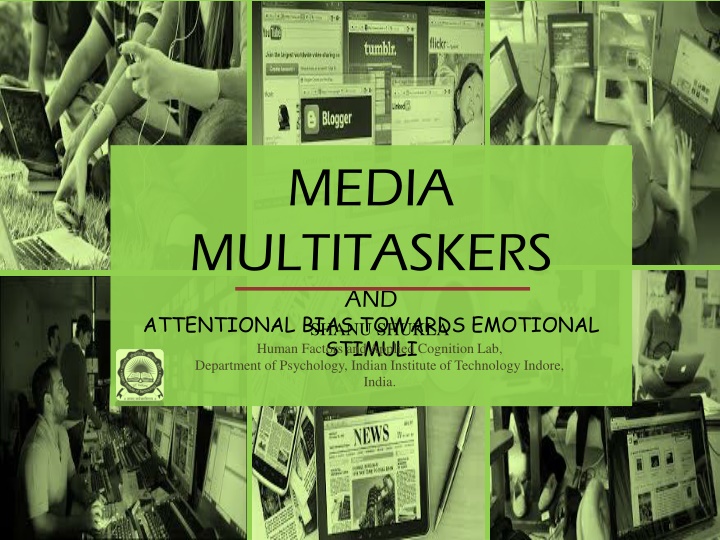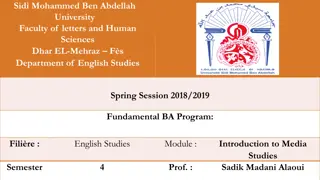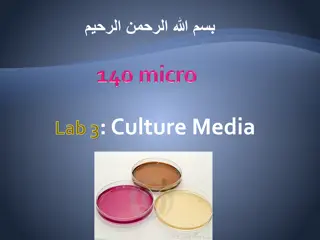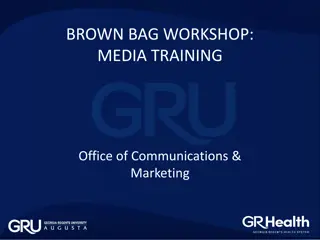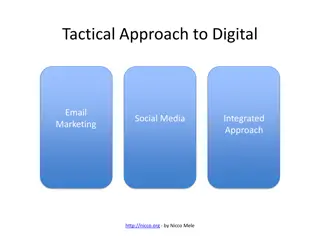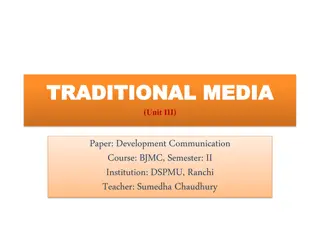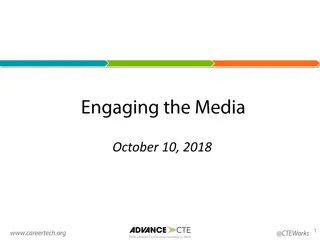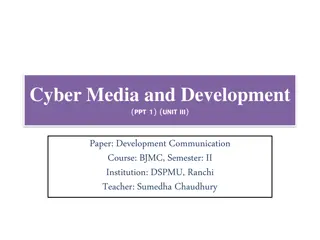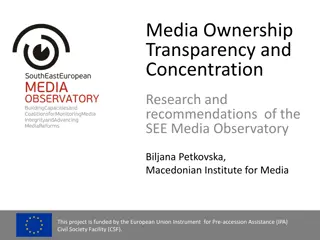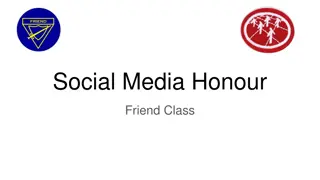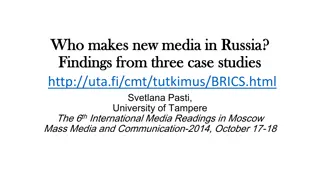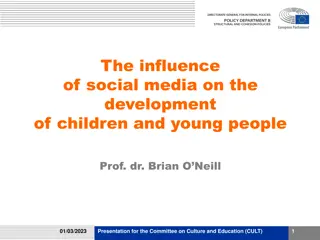MEDIA MULTITASKERS
This study explores the impact of media multitasking on attentional bias towards emotional stimuli. High and low media multitaskers are compared in their focus on positive, negative, or neutral stimuli. Research objectives, methodology, data analysis, results, and implications are detailed.
Download Presentation

Please find below an Image/Link to download the presentation.
The content on the website is provided AS IS for your information and personal use only. It may not be sold, licensed, or shared on other websites without obtaining consent from the author.If you encounter any issues during the download, it is possible that the publisher has removed the file from their server.
You are allowed to download the files provided on this website for personal or commercial use, subject to the condition that they are used lawfully. All files are the property of their respective owners.
The content on the website is provided AS IS for your information and personal use only. It may not be sold, licensed, or shared on other websites without obtaining consent from the author.
E N D
Presentation Transcript
MEDIA MULTITASKERS AND ATTENTIONAL BIAS TOWARDS EMOTIONAL STIMULI Department of Psychology, Indian Institute of Technology Indore, India. SHANU SHUKLA Human Factors and Applied Cognition Lab,
TOPIC OVERVIEW O U T L I N E RESEARCH OBJECTIVES METHODOLOGY DATA ANALYSIS RESULTS DISCUSSION CONCLUSION REFERENCES
WHAT IS Media Multitasking? Media multitasking refers to simultaneous consumption of two or more media at the same time... Those who media multitask is know as Media Multitaskers.
Zoning Out Individualswith HIGH Media Multitasking habits results in Mind Wandering Behavior spacing Out Attention Related Problems Attention Related Problems Task Unrelated Thoughts Mind wandering Behavior Their breadth biased (Lin, 2009; Ophir, Nass & Wagner, 2009) behavior style incline them to pay attention to a large set of stimuli Result: They become susceptible to interferences.
But in the environment the nature of stimuli can be emotional positive, negative or neutral. In the realistic scenario, one may ask whether the Media Multitaskers (High and Low) follow the breadth biased focused style or are they biased towards any one of the positive, negative or neutral stimuli on the basis of their recurrent thoughts.
RESEARCH OBJECTIVES Through the FACIAL DOT PROBE TASK (MacLeod, C., Mathews, A., & Tata, P., 1986) one aim to know two things: 1. Whether High Media Multitaskers (HMM) focuses upon all stimuli in a similar way or will they show preferences towards emotional stimuli as compared to Low Media Multitaskers (LMM). 2. Which kind of attentional bias will HMM display towards facial emotional stimuli- positive or negative.
METHODOLOGY SAMPLE A total of 30 participants voluntarily participated in the experiment. Their demographic profile is mentioned in TABLE 1. No. Of Participants 30 No. Of Male (M)/Female (F) M = 18, F = 12 Age Range 16-22 years Mean (M) age 19.3 years Standard Deviation (SD) 1.25 Educational Qualification B Tech (First and Second year) TABLE 1: Demographic Profile of Participants
MATERIALS Media Multitasking Questionnaire (Ophir, Nass, & Wagner, 2009), Facial Dot probe Task (Designed and presented experimentally through OpenSesame software (Math t, S., Schreij, D., & Theeuwes, J., 2012)). PROCEDURE The experiment was divided into two sessions. In the first session, participants were required to complete demographic and media multitasking questionnaire. In the second session a computerized task was presented to them that involves facial dot probe task. The task involves the following components (FIGURE 1).
Fixation Dot (500ms) + Facial Stimulus* (1000 ms) Target Probe (Until response) + FIGURE 1: Facial Emotion Recognition Task Components *Facial stimuli are taken from the Indian Movies Face Database (S.Setty et al, 2013) and Amsterdam Dynamic Facial Expression Set (Van der Schalk, J., Hawk, S. T., Fischer, A. H., & Doosje, B.,2011). Number of Trials = 192
DATA ANALYSIS Response time was recorded for target dot probe through experimentation system. Errors in locating the target probe and a response time of more than 2000msec were omitted in data analysis.. To compare the performance, a Mann Whitney U test was performed and results then accordingly interpreted. The Attention Bias score was calculated according to Bullock & Bonanno, (2013) criteria. Score of MMI questionnaire is based on its scoring pattern. To avoid any hemispheric based affective differences, all left handed participants were omitted from statistical analysis.
RESULTS SPSS Package 20 has been used to analyze the data. Two Data were omitted from final analyses, resulting in total participants = 28. PART 1 Media Multitasking Questionnaire: To identify HMM and LMM, Ophir, Nass and Wagner (2009) study criteria has been adopted. n m h = i MMI = i i X total h total h 1 Where, mi is the number of media typically used while using primary medium i, h is the total number of hours spent on an average day using primary medium i, and htotal is the total number of hours spent on an average day with all primary media. MMI produced a relatively normal distribution with a mean of 3.15 and Standard Deviation 0f 1.25. Based on the Mean-Split Approach , HMM and LMM were calculated. (Refer TABLE 2)
Participants Male Total Female HMM LMM 14 14 9 8 5 6 TABLE 2 : No. Of Participants identified as HMM and LMM PART 2 Average Response Time for Dot Probe in facial stimulus pair combinations for HMM (TABLE 3) and LMM (TABLE 4) High Media Multitaskers (HMM) Neutral-Negative Trials Neutral Cues Negative Cues 550.55 699.55 Neutral-Positive Trials Neutral Cues 698.76 Positive cues 491.49 Average Response Time (SD) (in msec) (77.84) (65.86) (118.74) (86.89) TABLE 3
Low Media Multitaskers (LMM) Neutral-Negative Trials Neutral Cues Negative Cues 484.93 380.60 Neutral-Positive Trials Neutral Cues 582.02 Positive cues 598.75 Average Response Time (SD) (in Msec) (57.96) (83.15) (122.22) (56.94) TABLE 4 A Mann -Whitney U test was carried out among HMM and LMM group with respect to response time in different cues among neutral-negative trials and neutral-positive trials.
Significant difference between HMM and LMM with respect to response time in positive cues during neutral-positive trials; U = 30.00, p < 0.05. Significant difference between HMM and LMM with respect to response time in neutral cues during neutral-positive trials; U = 38.00, p < 0.05. U test result for negative cues in neutral- negative trials, and the difference found to be significant; U = 2.00, p < 0.05. Also for neutral cues in neutral- negative trials, the difference between HMM and LMM was significant; U = 51.50, p < 0.05. This suggests that different groups of Media Multitaskers respond differently to emotional and neutral stimulus.
PART 3 Attentional Bias scores among HMM and LMM POSITIVE ATTENTIONAL BIAS Positive Attentional Bias score for HMM = 207.27. Positive Attentional Bias score for LMM = -16.73 SIGNIFY: HMM prefers allocation of attention towards positive cues in neutral-positive stimuli trials. However, LMM (-16.73) seemed to allocate attention towards neutral cues in neutral-positive stimuli trials; but the bias seemed to be very small which can be treated as no bias score towards positive or neutral face in neutral-positive trials.
PART 3 Attentional Bias scores among HMM and LMM NEGATIVE ATTENTIONAL BIAS Negative Attentional Bias score for HMM = -149 Negative Attentional Bias score for LMM = 104.33 SIGNIFY: For HMM, attentional bias was towards neutral cues in neutral-negative stimuli trials which display an avoidance tendency among HMM towards negative facial stimuli. In case of LMM (score = 104.33), it displayed an attentional bias towards negative facial stimuli in neutral-negative stimuli trials
DISCUSSION Result from the current study highlights the following relevant issues: In case of neutral-positive facial pairing , HMM group reflects positive bias while there was no significant bias towards neutral or positive stimuli in case of LMM group. This suggests that the HMM orient attention towards positive stimuli in the environment. EVIDENCE : Song, Nam, Lim, & Kim (2013) study where participants indulge in media multitasking behavior in order to avoid negative emotions like boredom. In case of neutral-negative facial pairing it was found that LMM reflects negative bias but HMM reflects bias towards neutral stimuli; with relative to negative stimuli. EVIDENCE: For LMM group negative bias is supported by evolutionary theory which suggests that individual pay attention to negative stimuli for survival reasons.
But lack of negative bias in HMM may reflect the tendency to avoid negative cues or to look for positive cues in the environment. Evidence: Burke and Develin (2016) found that on Facebook, posts with positive feelings received more likes than those posts which had negative feelings. Greenfield, P (2010) highlights reduced empathy among college students due to overreliance on technology for communication and relationship building. It can also be argued that in order to reduce anxiety, HMM may adopt an avoidance strategy towards negative stimuli. Besides, the task switching ability among HMM might have facilitated disengagement from negative stimuli due to large time (1000 msec) gap for presentation of facial stimuli pairs.
CONCLUSION HMM does not focus upon all the stimuli in a similar way. They indeed have some preferences and attention bias towards emotional stimuli such that they pay selective attention towards positive emotion when combined with neutral stimuli and display avoidance strategy towards negative stimuli when negative and neutral stimuli are present together.
APPLICATIONS/ LIMITATIONS The results of the study will be helpful in designing web sites or educational content for HMM . However due to small size results should be used with caution. Also, there are other moderators like emotional status of the individual that should be taken in the final results.
REFERENCES Bullock, A. B., & Bonanno, G. A. (2013). Attentional Bias and Complicated Grief: A Primed Dot- Probe Task with Emotional Faces. Journal of Experimental Psychopathology, 4, 194-207. doi:DOI:10.5127/jep.020411 Burke, M., & Develin, M. (2016). Once More with Feeling: Supportive Responses to Social Sharing on Facebook. CSCW '16. ACM. doi:10.1145/2818048 Greenfield, P. (2010). Social networking, mental health and human development. Paper presented at the Lab School of Washington s 15th Annual Scientific Research Conference. Washington, DC. Retrieved from test.baltimorelabschool.org/content/scientificconference Lin, L. (2009). Breadth-biased versus focused cognitive control in media multitasking behaviors. Proceedings of the National Academy of Sciences of the United States of America, 106 (37), 15521 15522. doi:http://doi.org/10.1073/pnas.0908642106 MacLeod, C., Mathews, A., & Tata, P. (1986). Attentional bias in emotional disorders. Journal of Abnormal Psychology, 95 (1), 15-20. doi:10.1037/0021-843X.95.1.15 Math t, S., Schreij, D., & Theeuwes, J. (2012). OpenSesame: An open-source, graphical experiment builder for the social sciences. Behavior Research Methods, 44 (2), 314-324. doi:10.3758/s13428- 011-0168-7.
REFERENCES Ophir, E., Nass, C., & Wagner, A. D. (2009). Cognitive control in media multitaskers. Proceedings of the National Academy of Sciences of the United States of America, 106 (37), 15583 15587. doi: http://doi.org/10.1073/pnas.0903620106 S.Setty et al. (2013). India Movie Face Database: A benchmark for face Recognition under wide variations. Computer Vision, Pattern Recogniton, Image Processing and Graphics (NCVPRIPG) (pp. 1-5). Jodhur: IEEE. Song, K.-S., Nam, S., Lim, H., & Kim, J. (2013). Analysis of Youngsters' Media Multitasking Behaviors and Effect on Learning. International Journal of Multimedia and Ubiquitous Engineering, 8 (4), 191-198. Retrieved from ww.sersc.org/journals/IJMUE/vol8_no4_2013/19.pdf Van der Schalk, J., Hawk, S. T., Fischer, A. H., & Doosje, B. (2011). Moving Faces, looking places:Validation of the Amsterdam Dynamic Facial Expression Set (ADFES). Emotion, 4, 907-920. doi:10.1037/a0023853 All images in the presentation are courtesy of Google images.
ACKNOWLEDGMENT The author thanks Human Factors and Applied Cognition Lab at Indian Institute of Technology Indore for all the technical and experimental support during the execution of this project and also acknowledge the University Grants Commission (UGC), Government of India for financial support.
THANK YOU For FEEDBACK and SUGGESTIONS, mail me at Shanu.shukla11@gmail.com
